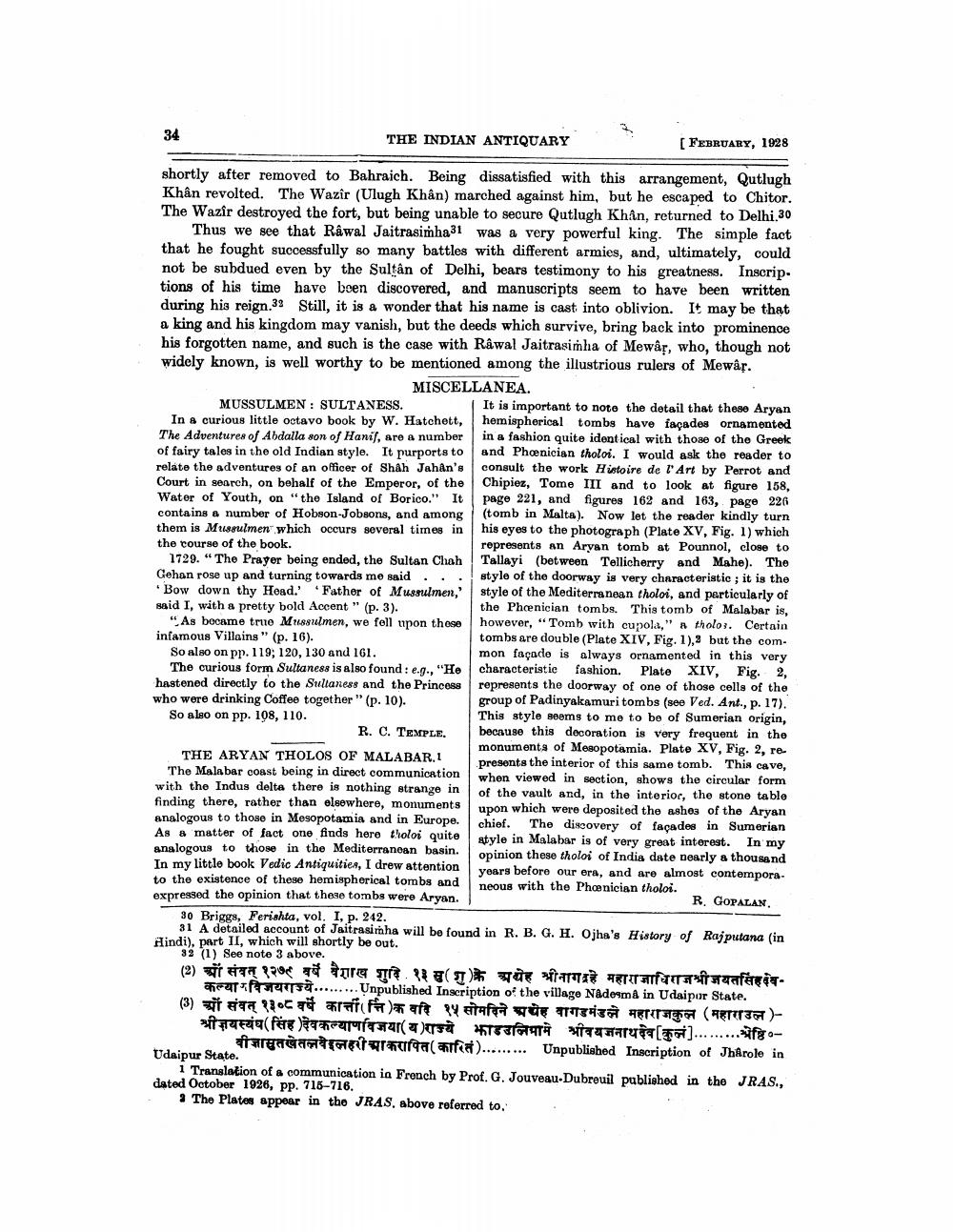________________
THE INDIAN ANTIQUARY
[FEBRUARY, 1928
shortly after removed to Bahraich. Being dissatisfied with this arrangement, Qutlugh Khân revolted. The Wazir (Ulugh Khân) marched against him, but he escaped to Chitor. The Wazîr destroyed the fort, but being unable to secure Qutlugh Khân, returned to Delhi 30
Thus we see that Rawal Jaitrasimha31 was a very powerful king. The simple fact that he fought successfully so many battles with different armies, and, ultimately, could not be subdued even by the Sultan of Delhi, bears testimony to his greatness. Inscrip. tions of his time have boen discovered, and manuscripts seem to have been written during his reign.32 Still, it is a wonder that his name is cast into oblivion. It may be that a king and his kingdom may vanish, but the deeds which survive, bring back into prominence his forgotten name, and such is the case with Rawal Jaitrasimha of Mewâr, who, though not widely known, is well worthy to be mentioned among the illustrious rulers of Mewâr.
MISCELLANEA. MUSSULMEN: SULTANESS.
It is important to note the detail that these Aryan In & curious little octavo book by W. Hatchett, hemispherical tombs have façades ornamented The Adventures of Abdalla son of Hanif, are a number in a fashion quite identical with those of the Greek of fairy tales in the old Indian style. It purports to and Phoenician tholoi. I would ask the reader to relate the adventures of an officer of Shah Jahan's consult the work Histoire de l'Art by Perrot and Court in search, on behalf of the Emperor, of the Chipioz, Tome III and to look at figure 158, Water of Youth, on "the Island of Borico." It page 221, and figures 162 and 163, page 226 contains a number of Hobson-Jobsons, and among (tomb in Malta). Now let the reader kindly turn them is Mussulmen which occurs several times in his eyes to the photograph (Plate XV, Fig. 1) which the course of the book.
represents an Aryan tomb at Pounnol, close to 1729. "The Prayer being ended, the Sultan Chah Tallayi (between Tellicherry and Mahe). The Gehan rose up and turning towards me said... style of the doorway is very characteristic ; it is the
Bow down thy Head.''Father of Mussulmen,' style of the Mediterranean tholoi, and perticularly of said I, with a pretty bold Accent" (p. 3).
the Phoenician tombs. This tomb of Malabar is, "As bocame true Musulmen, we fell upon those however, "Tomb with cupola," tholos. Certain infamous Villains" (p. 16).
tombs are double (Plate XIV, Fig. 1), but the com. So also on pp. 119, 120, 130 and 161.
mon façade is always ornamented in this very The curious form Sultaness is also found : e.g., "He characteristic fashion. Plate XIV, Fig. 2, hastened directly to the Sultaness and the Princess represents the doorway of one of those cells of the who were drinking Coffee together" (p. 10).
group of Padinyakamuri tombs (see Ved. Ant., p. 17). So also on pp. 108, 110.
This style seems to me to be of Sumerian origin, R. C. TEMPLE because this decoration is very frequent in the
monuments of Mesopotamia. Plate XV, Fig. 2, reTHE ARYAN THOLOS OF MALABAR.1
presents the interior of this same tomb. This cave, The Malabar coast being in direct communication
when viewed in section, shows the circular form with the Indus delta there is nothing strange in
of the vault and, in the interior, the stone tablo finding there, rather than elsewhere, monuments
upon which were deposited the ashes of the Aryan analogous to those in Mesopotamia and in Europe.
chief. The discovery of façades in Sumerian As a matter of fact one finds here tholoi quite
style in Malabar is of very great interest. In my analogous to those in the Mediterranean basin.
opinion these tholoi of India date nearly a thousand In my little book Vedic Antiquities, I drew attention
years before our era, and are almost contempora to the existence of these hemispherical tombs and neous with the Phoenician tholoi. expressed the opinion that these tombs were Aryan.
R. GOPALAN 30 Briggs, Ferishta, vol. I, p. 242.
31 A detailed account of Jaitrasimha will be found in R. B. G. H. Ojha's History of Rajputana (in Hindi), part II, which will shortly be out.
33 (1) See note 3 above. (2) ओं संवत् १२७८ वर्षे वेशाख शुदि. १५ स(श)के अोह श्रीनागनहे महाराजाधिराजश्रीजयतसिंहदेवaut f
......... Unpublished Inscription of the villago Nadesma in Udaipur State. (3) ओं संवत् १३०८ वर्षे काती(नि)क वदि १५ सोमदिने अयेह वागडमंडले महाराजकुल (महाराउल)terezia(fea
() T539 Taryti).........fofargè
ricirea afa)......... Unpublished Inscription of Jharole in Udaipur State.
1 Translation of a communication in French by Prof. G. Jouveau-Dubreuil published in the JRAS., dated October 1926, pp. 716-716.
The Plates appear in the JRAS, above referred to




